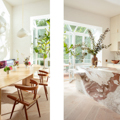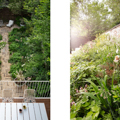American architect Elizabeth Roberts has come to be known as a master of the Brooklyn brownstone. Trained in both architecture and historic preservation, Roberts has made a name for herself by breathing new life into New York City’s nineteenth-century town houses, restoring eighteenth-century country houses, and constructing modern dwellings from the ground up. In a field where only seventeen percent of registered architects are women, Roberts has sustained a multi-decade career developing spaces for New York creatives and elite.
Roberts’s firm, Elizabeth Roberts Architects (also referred to as ERA), is an architecture and design studio based in the Gowanus neighborhood of Brooklyn. ERA is known for highlighting original and historic elements of each project while creating an environment that reflects the relaxed ethos of its home borough. Roberts and her firm consider architecture, design, and objects in equal measure and aim for an aesthetic that feels both natural and authentic—one that preserves the best of the past while producing new points of view.
Originally from Marin County, California, Roberts received a bachelor’s degree in architecture from the University of California at Berkeley, becoming interested in history and classicism after spending a summer at an archaeological site in Greece. Roberts moved to New York in 1994 and received a master’s degree in historic preservation from Columbia University. Early in her career, Roberts worked for the Manhattan firm Beyer Blinder Belle, and later for architect Alice Carey in San Francisco.
Roberts’s repertoire includes houses for interior designer Athena Calderone, fashion designers Rachel Comey and Ulla Johnson, and the actress Maggie Gyllenhaal. Johnson describes Roberts as “really great at designing spaces that feel generous and elegant but also suited to family living.” She further notes that her designs are “not token holiday homes. The people she works with are renovating these spaces to grow old in.” Well-versed in commercial design as well as residential, Roberts and her team at ERA also created New York retail spaces for both Comey and Johnson.
As New York City domestic ideals shifted from uptown penthouses to Brooklyn brownstones, questions arose around the transformation of buildings and neighborhoods that long housed immigrant families and working-class residents. A 1969 New York magazine cover story explored the downsides of what it called “Brownstone Fever,” a postwar period during which a buyer could secure a brownstone in Brooklyn neighborhoods such as Boerum Hill, Fort Greene, or Park Slope for roughly $50,000 and fully renovate the building for an additional $60,000. The designation of Brooklyn neighborhoods as historic districts in the early 1970s increased interest and subsequently expedited the rate of gentrification. While many bemoaned Brooklyn’s changing culture and property values as a result of this gentrification, others felt this form of development ultimately preserved blocks of town houses that might have otherwise been demolished as part of urban renewal plans. Roberts acknowledges that “a lot has happened to these houses in one-hundred-and-fifty years. It’s about balancing the old and new.” That is, preserving the past while also designing for contemporary life.
Roberts has garnered press and recognition for her signature design sensibilities. In 2019 Roberts was dubbed the "titan of the town house" by the New York Times. The prominent publication described hallmark features of Roberts’s work: expanded rear facades with glass-walled extensions, elevated wood-burning fireplaces, white-walled rooms, and modern furniture mixed with period details. Roberts shared: “My interest was, and still is, adapting old buildings, reusing them, changing them.” Architectural Digest has named ERA to its AD100 roster multiple times, describing the firm as having developed a cult following due to its unique approach to spatial planning, its centerpiece kitchens, and its sophisticated materials palettes.
Notable ERA projects include the Johnson-Miner Townhouse in Fort Greene, the Rachel Comey Flagship store in SoHo, and the Warren Mews Townhouse in Cobble Hill. Beyond New York City, ERA has completed residential projects in the Hudson Valley and a ground-up construction of a country house in the Catskills. At present, the firm employs around twenty architects and interior designers.
References
Cochran, Sam. “AD100 Architect Elizabeth Roberts Crafts a Dreamy Office Sanctuary.” Architectural Digest, January 19, 2021.
Dawson, Kelly. “Warren Mews Townhouse by Elizabeth Roberts Architects.” Dwell, June 24, 2021.
“Elizabeth Roberts Architecture & Design.” Architectural Digest, December 12, 2018.
“ERA.” Elizabeth Roberts Architects. Accessed November 30, 2021. https://www.elizabethroberts.com/.
Hellman, Peter. “The Consequences of Brownstone Fever.” New York Magazine, March 31, 1969.
Howorth, Bebe. “The New Furniture Collection Has the Exact Three Pieces You Need.” ELLE Decor, March 5, 2021.
Kurutz, Steven. “So You Want to Blow Out Your Brooklyn Brownstone.” New York Times, May 1, 2019.
Reggev, Kate. “In Praise of Precedent: How Do Architects Use History for Inspiration?” Architect's Newspaper, February 26, 2020.
Schwiegershausen, Erica. “How a Cult-Favorite Architect Gets It Done.” The Cut, December 16, 2019.
Ten Have, Mieke. “Architect Elizabeth Roberts Builds the Rooms Powerful Women Want and Need.” Cultured, December 25, 2019.
Yeston, Emily. “Career / Elizabeth Roberts.” DORÉ, 2019. https://www.wearedore.com/features/career-elizabeth-roberts/.
“Women in Architecture.” American Institute of Architects, Jan 6, 2020. https://www.aia.org/.
Writing Credits
If SAH Archipedia has been useful to you, please consider supporting it.
SAH Archipedia tells the story of the United States through its buildings, landscapes, and cities. This freely available resource empowers the public with authoritative knowledge that deepens their understanding and appreciation of the built environment. But the Society of Architectural Historians, which created SAH Archipedia with University of Virginia Press, needs your support to maintain the high-caliber research, writing, photography, cartography, editing, design, and programming that make SAH Archipedia a trusted online resource available to all who value the history of place, heritage tourism, and learning.












